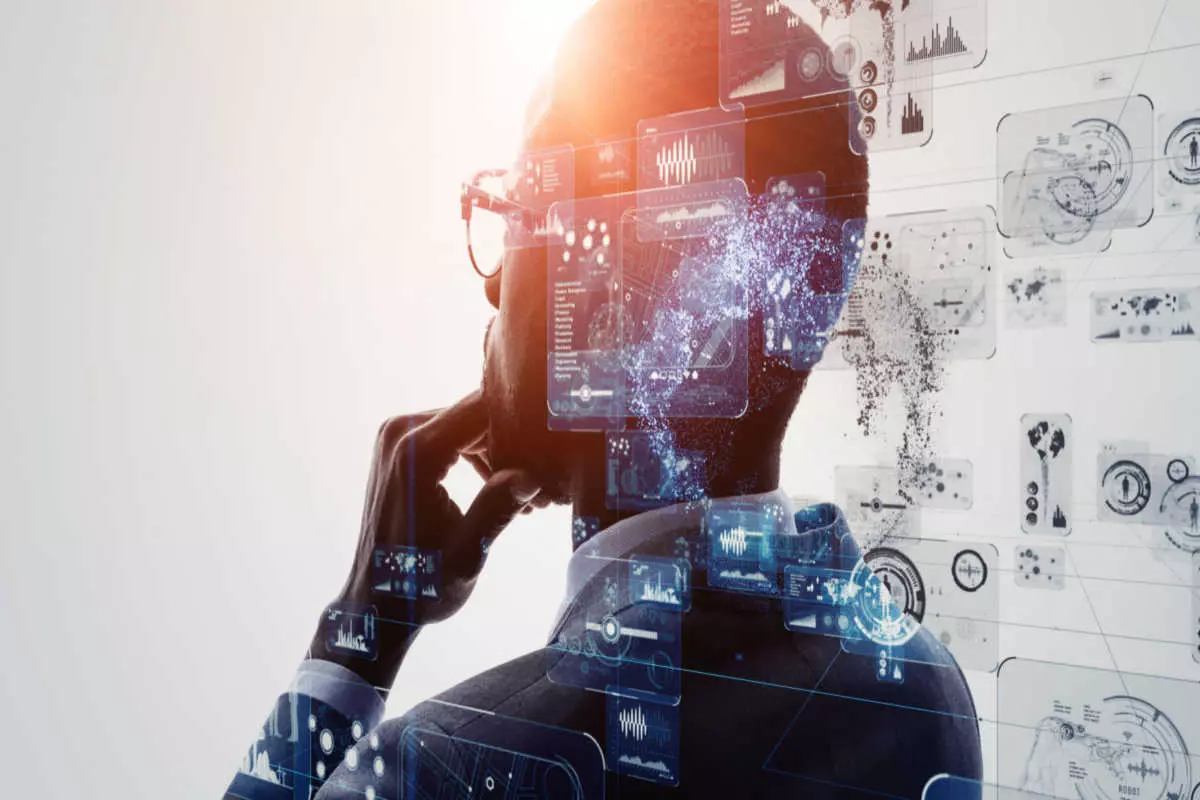AI as an Example of Advanced Digital Technology
Artificial intelligence is an example of digital technology that has been changing various industries for several years now. For instance, the statistics show that the global AI spending market was valued at $11.6 billion in 2017 and is predicted to reach $516 by 2027.
However, as a leading example of advanced technology, artificial intelligence has many controversial opinions. Some people, including tech billionaire and Twitter CEO Elon Musk, believe that AI is dangerous for humanity’s future and threatens people’s jobs and privacy. But there’s no point in denying that it automates a myriad of rigid human tasks in healthcare, finance, and other sectors.
With that said, this blog will discuss some of the most groundbreaking implications of AI and why it is an advanced technology we’re so excited about. But first, let’s clarify what we mean by advanced technology.
Advanced Technology Definition
Put simply, advanced technology is a type of technology that’s still in its infancy but vows to materialize into a widespread technology in the near future. Advanced technology usually has few users at a given time but is expanding rapidly and spreading into other spheres and areas of life. Current types of technology that can be considered advanced include artificial intelligence, virtual reality, 3D modeling, data mining, and real-time collaboration.

AI is the most prominent example of digital technology that is advancing rapidly. Companies increasingly invest in AI tools as they speed up repetitive tasks, decrease errors, and promote efficiency. It also serves as a base for developing other technology, such as speech recognition and enhanced user authentication. Only a decade ago, artificial intelligence was utilized by a few companies, and the results were believed to be revolutionary. Today, we can observe almost every industry adopting new AI technology to improve business processes.
As we will see in the following sections, AI plays a huge part in all major industries, but in most cases, it is still combined with manual labor and needs human intervention to deliver the desired results. This is why we still consider artificial intelligence an advanced technology.
AI Applications in Finance
AI is revolutionizing the finance industry from scratch. From automated financial investing to identifying loan applicants’ creditworthiness, AI plays a huge role in how financial institutions operate. Across all sectors of financial services, more than 75% of companies utilize at least one AI computing tool, whether it is machine learning (ML), deep learning, or high-performance computing (HPC). Here are some examples of digital technologies used in the finance and banking industry:
Algorithmic Trading
AI allows financial institutions to make trading decisions and perform millions of trades with the help of an algorithmic trading system. It is most commonly used by large corporations such as NASDAQ and Dow Jones, where trading large volumes of securities would be impossible to complete manually. This technology can determine a profitable pattern based on market price or options. Then, the algorithm can start buying or selling securities at a higher frequency and speed than humans.
Automated Financial Investments
Many companies have AI agents that use natural language processing to analyze reports, news, and social media content. Then, the AI agents assign scores to particular investment opportunities. This helps upper management make more informed investment decisions. For example, BlackRock’s AI agent, Aladdin, uses both internal and external data to process investment decisions and, as of today, has managed $21.6 trillion in assets.
Risk Assessment of Loans
With the help of AI and ML tools, lending companies can perform more thorough checks to identify the creditworthiness of loan applicants. Trending software like TIBCO and Squirro go beyond the applicant’s credit score and income to determine their eligibility. These AI and ML software analyze other factors in databases, such as receipt of public assistance and child support applications. This way, lenders can accurately determine applicant qualifications and significantly reduce defaults.
Fraud Detection
AI assists banks and other financial institutions in identifying fraudulent behavior. AI tools can track patterns in operations and bookkeeping and send a signal when suspicious activity arises. Analyzing large chunks of data can inform the managers if specific transactions don’t follow regular transacting patterns, thus helping catch fraud early and preventing theft and data breaches. Companies like Kasisto and Moneystream offer AI tools to combat fraud in the financial sector.
AI Applications in Healthcare
Healthcare is another industry that AI is transforming drastically. Practitioners can now diagnose patients more precisely and with the technical precision of machines thanks to AI-backed tools and robots.
Computational Sophistication
A great example of digital technology in healthcare is the adoption of deep learning in clinical decision support systems. These computer-based programs assist healthcare workers by analyzing data and providing information such as clinical guidelines, reports, summaries, and documentation templates. With the help of deep learning, machines can be trained to differentiate between regular and irregular health conditions. This, in turn, can reduce the number of misdiagnosed patients. Additionally, it is believed that AI helps prevent cancer from taking 22,000 human lives each year.
For instance, the German company Meantix applies deep learning to detect lymph nodes in the human body in CT images. These scans are usually performed by radiologists and cost about $100 per image. However, a single machine can now perform the same task 10,000 times for a total cost of $250,000 instead.
Robot-Assisted Surgeries
Some hospitals already utilize robots or AI surgeons during many high-stakes procedures, such as open-heart surgeries. Robots bring more precision and control to tasks that require special attention, eliminating the possibility of human error, which can be detrimental to the patient’s health. Usually, the procedure is done by the surgeon sitting at the computer and controlling the robot’s mechanical arms. This lets the surgeon have a three-dimensional view of the surgical site – something that is impossible to view with the human eye.
Additionally, complications, pain, and recovery times are all reduced after robot-assisted surgeries. These surgeries are reported to decrease the patient’s time spent at the hospital by 20%. Readmittance to the hospital within 90 days is also reduced to 21% compared to 32% with regular surgeries.
AI Applications in Lifestyle
We can also notice many examples of digital technology in our everyday life. From our smartphones to vehicles, what was once considered science fiction is now the reality. Here are some highlights of AI influencing different touchpoints in our lives:
- Self-Driving Cars: AI-powered cars are built with sensors that capture various data points like car speed, pedestrian positions, and road conditions. As a result, these cars can take automatic and immediate actions, such as emergency braking, blind-spot detection, and driver-assist steering. While these cars aren’t widely available for sale yet, more than 33 million self-driving cars are projected to hit the roads by 2040.
- Facial Recognition: Widely available in many new smartphone models, such as the iPhone X and above, facial recognition elevates the security of our gadgets. It is AI that allows you to unlock your phone by recognizing your facial features.
- Spam Filters: An example of digital technology can also be observed in our email inboxes. With a 98.7% accuracy rate, spam filters utilize AI to categorize your inbox and send suspicious emails directly to the spam folder, preventing you from clicking on any potential malware.
- Recommendations: You have probably noticed how platforms such as YouTube, Spotify, and Apple Music constantly recommend songs and videos that might interest you. At the core of these functions is AI, which analyzes your preferences and comes up with suggestions based on what you usually listen to and watch.
AI Applications in National Security
Governments worldwide are already deploying AI tools to strengthen national security. An example of digital technology in this sector includes machines that replace soldiers on the battlefield, saving lives. In fact, AI has already shifted military and national security so much that a new term has been coined – hyper war, which represents the age of AI-powered warfare with little human involvement.
With that said, below are some use cases of AI in national security:
- Command and Control Systems: An integral shift can be observed in command and control systems – the organizational processes involving human, physical, and technological resources to perform military tasks. With the help of AI, commanders can accelerate certain routine military tasks and decisions in the blink of an eye.
- Unmanned Combat Aerial Vehicles (UAV): Various countries, including the U.S, Russia, and China, use UAVs to monitor hazardous locations instead of risking humans. For example, an American company, General Atomics, is building AI to enable UAVs to navigate and locate the enemy. When using drone surveillance, the vehicle captures images, analyzes them, and makes decisions based on the data.
- Cybersecurity: In the era of hyper-war, old cybersecurity systems also become fragile to new technologies. Therefore, as an example of digital security, governments use AI to reinforce security systems protecting the safety of citizens. For instance, China’s National Security Council plans to build an AI-led domestic security industry worth $150 billion by 2030. The Chinese company Baidu is already implementing facial recognition software that helps find missing people. Various cities are also heavily investing in AI to combat terrorism, prevent crimes, and improve speech recognition programs.
Smart Cities
A smart city is an emerging type of urban area that incorporates different forms of technology to collect data. This data is later used to manage resources and monitor various aspects of city life, including transportation, utilities, and waste management.
Several American cities are deploying smart city technologies to facilitate service delivery, environmental planning, and energy utilization. For instance, the Fire Department of Cincinnati uses data analytics to identify medical emergency responses. This example of digital technology driven by AI is able to decide whether a patient can be treated on-site or needs to be taken to the hospital, taking into account several factors, including the weather, location, and the type of emergency call.
Similarly, Boston uses cameras that oversee traffic and are able to detect gunshots and alert the respective authorities. San Francisco, New York City, and Seattle are among the top smart city surveillance systems adopters.
Bottom Line
All in all, artificial intelligence continues to penetrate almost every aspect of our lives. The most promising example of digital technology aids employees in healthcare and finance by reducing repetitive tasks and systemizing operations. It also plays a massive part in the everyday activities of citizens by reinforcing security measures and providing accessibility through our phones and vehicles.
Try our real-time predictive modeling engine and create your first custom model in five minutes – no coding necessary!
- Fully operational AI with automated model building and deployment
- Data preprocessing and analysis tools
- Custom modeling solutions
- Actionable analytics
- A personalized approach to real-time decision making
Table of Contents
- Advanced Technology Definition
- AI Applications in Finance
- Algorithmic Trading
- Automated Financial Investments
- Risk Assessment of Loans
- Fraud Detection
- AI Applications in Healthcare
- Computational Sophistication
- Robot-Assisted Surgeries
- AI Applications in Lifestyle
- AI Applications in National Security
- Smart Cities
- Bottom Line



